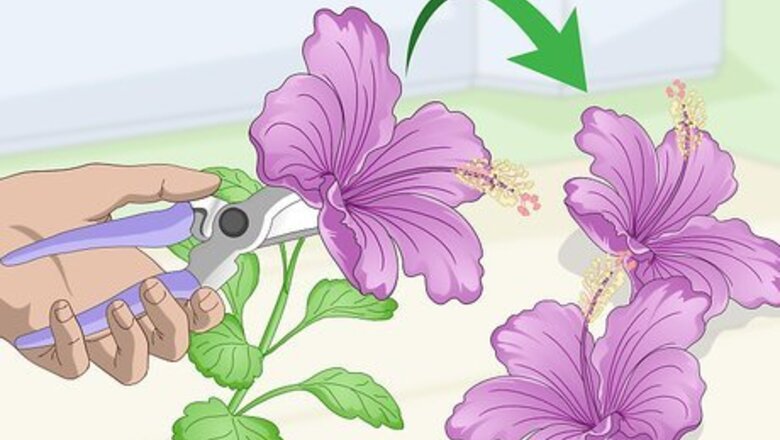
views
X
Research source
Using Silica Gel for Crafts
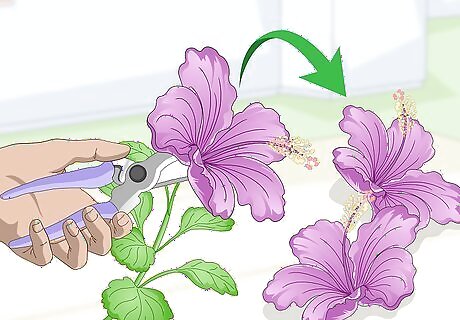
Cut the stem off of a hibiscus flower. Leave a ⁄2 in (1.3 cm) stub at the bottom of the blossom so that it will be easier to handle. Make sure that the flower you are using is completely dry and does not have any holes, tears, or bruising. Do not use this method if you wish to use the flowers for food, drink, or cosmetics. Silica gel will render the petals inedible.
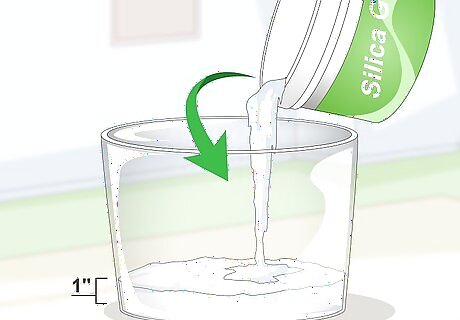
Pour 1 inch (2.5 cm) of silica gel into a glass or plastic container. Choose a container that is wider and deeper than your flower. If you want to dry more than 1 hibiscus flower, make sure that the container is wide enough to fit all of the flowers with space between them. Fill the container with 1 inch (2.5 cm) of silica gel. You can find silica gel in the floral section of a craft store. Contrary to its name, it is actually a white, powdery substance. The amount of space you leave between multiple flowers does not have to be exact. As long as the petals are not touching, you will be fine.
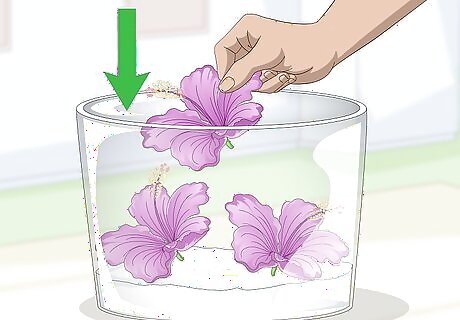
Place the flower stem-first into the silica gel. The ⁄2 in (1.3 cm) stub at the bottom of the flower will help keep it upright while it dries. Make sure that the undersides of the petals are touching the silica gel.
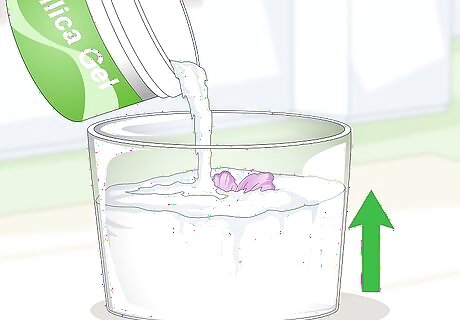
Cover the flower with more silica gel. Pour the silica gel slowly over and around the flower so that you don't crush the petals. Keep adding the gel until the flower is completely covered. Ideally, you should have a 1 in (2.5 cm) thick layer of silica gel on top of the flower.
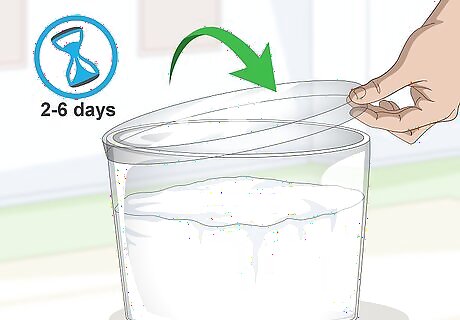
Cover the container with a lid and leave it alone for 2 to 6 days. Make sure that the lid is on tightly, as any moisture could prevent the silica gel from working properly. Place the container some place where it won't get accidentally bumped or moved, as this can ruin the flower. The place should be dry and dark, not humid. A cabinet would be ideal. Check the flower after 2 days. If it is not dry and papery, cover it back up with silica gel, and wait longer.
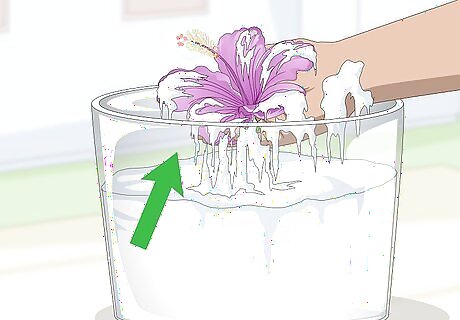
Take the flower out of the silica gel. Once the 2 to 6 days have passed, open the container and pour out enough of the silica gel to reveal the flower. Scoop the flower up from the bottom with your fingers. Be very careful with it as it will be delicate.
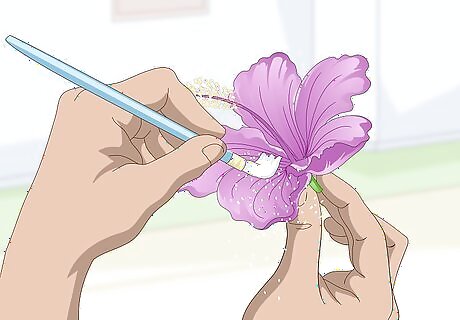
Dust excess silica gel off of the flower with a soft brush. Camel hair paintbrushes and powder brushes work great for this. Avoid using stiff brushes as they may tear the flower. Use the brush to delicately wipe off any excess silica that may be clinging to the petals. If you are worried about the flower falling apart, you can place a drop of clear-drying glue into its center. The glue will help hold the petals together once it dries.
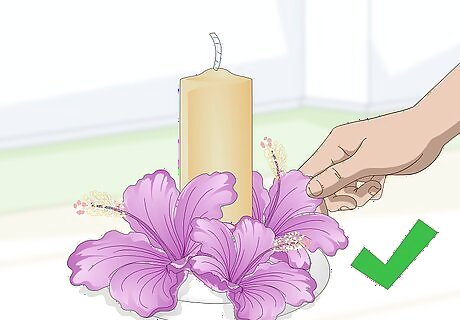
Use the dried flower in crafts. You can decoupage the flower onto a box or card, or you can add it to a homemade candle. If you aren't happy with the flower's shape, you can add it to a bowl of potpourri. Do not use these flowers in soaps, teas, or makeup. The silica gel would render them unsafe for consumption and cosmetic use.
Drying Hibiscus Flowers Outside
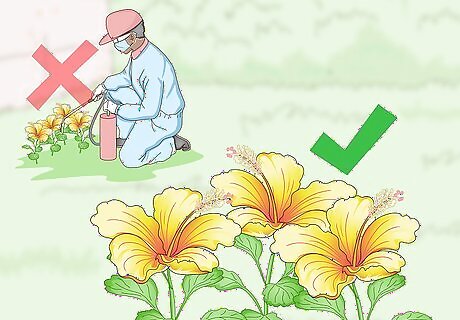
Find a pesticide-free hibiscus if you are using it for food or cosmetics. This is very important as water may not enough to get rid of any pesticides. For the best flavor, use the hibiscus sabdariffa variety. If you are simply drying the flowers for craft projects, they do not have to be pesticide-free.
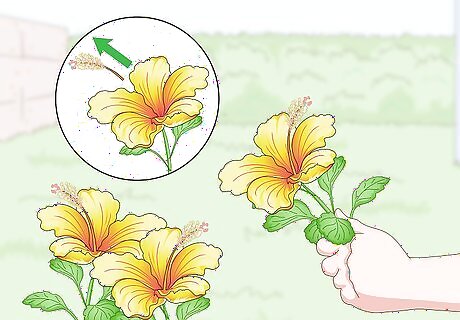
Pick the flowers and remove the stamens. Pick the flowers off of the plant 1 by 1, and place them into a bowl or basket. Once the container is full, go through the flowers, and pull off the yellow stamens in the center. Leave the stems on the flower, as this will make them easier to dry. Plan on using 8 to 10 flowers for a single pot of tea.
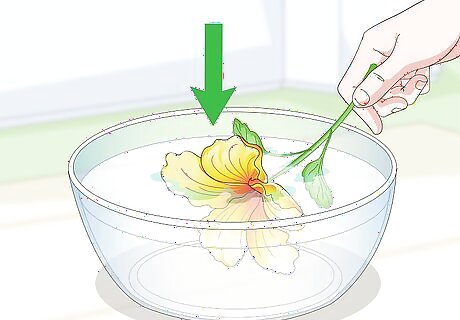
Dip the flowers in water to remove any dust and insects. Fill a large, clean bowl with water. Working 1 flower at a time, dip the flowers into the water, swish it around, then lift it out and set it aside. The swishing will help dislodge anything caught between the petals and the green part. If the plant had insects on it, be sure to pry open the petals and the green part of the flowers once the flower is under the water.
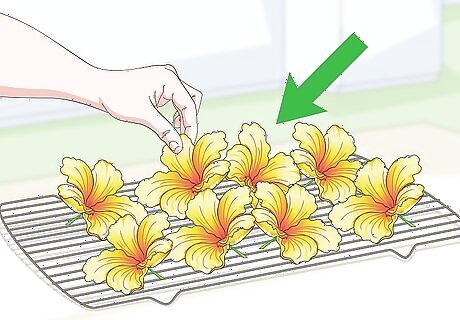
Spread the flowers out on a drying rack. This can be an actual drying rack used for cooling off baked goods, or it can be a small, clean window screen. You can even use a crisper sheet that you use for making cookies.
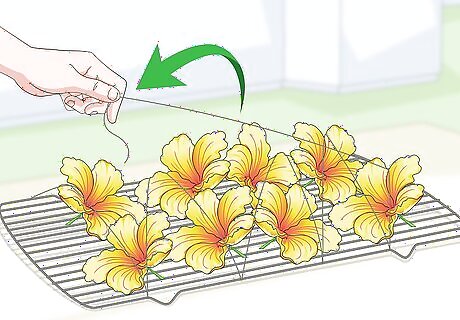
Secure the flowers with thin wire if it is windy. Weave thin wire over the flowers and under the holes on the drying rack. Keep the wire taut enough so that it keeps the flowers secure, but loose enough so that it doesn't crush the flowers. Keep the flowers at an angle under the wire, so that the wire goes between the petals. You can use any type of thin wire, such as jewelry wire or floral wire. You can even use twist ties from a pack of garbage bags.
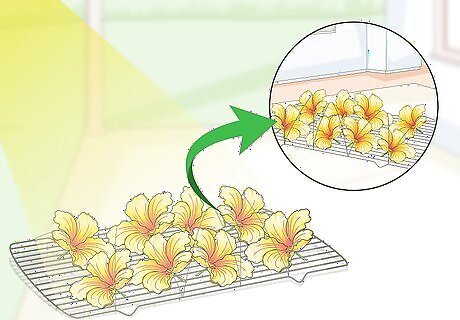
Leave the flowers outside in the sun, but bring them inside at night. Keep doing this every day until the flowers dry completely. They will shrink and turn brittle. How long this takes depends on how dry or humid it is, as well as how sunny it is. Expect to wait at least 3 days. It is very important that you bring the flowers indoors for the evening, as any morning dew will reverse the drying process. Keep the flowers in the driest, sunniest spot in your garden, patio, or balcony. Check on the flowers once or twice daily until they dry. If you notice that the flowers are only drying on 1 side, rotate them.
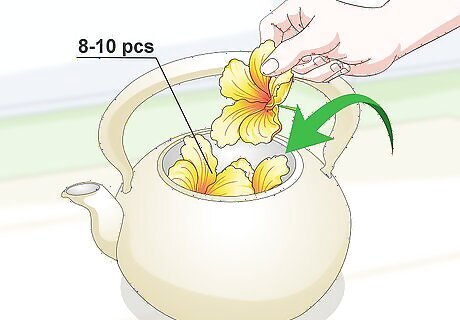
Use 8 to 10 flowers to brew a pot of tea. Place 8 to 10 dried hibiscus flowers into a tea pot. Add some flavoring if desired, then fill the pot with boiled water. Let the tea steep for 20 minutes, then strain it. Sweeten the tea with honey, if desired, then serve it hot or cold. For a warm, sweet flavor, add a pinch of cinnamon and a slice of prance peel. If you want something refreshing, try a mint leaf and a slice of orange peel. For a more tart flavor, add a squeeze of lime just before serving the tea.
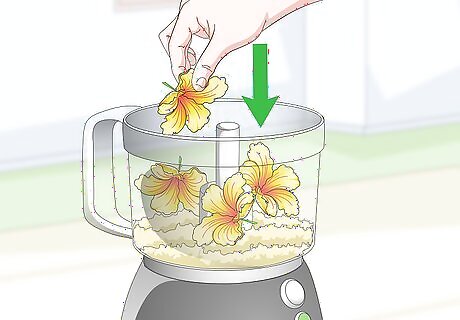
Grind the flowers into a powder if you wish to use them for cosmetics. Grind the petals into a fine powder in a blender. Pour the petals through a fine, mesh sieve into a jar, to help break them up further. Close the jar, and use the powder as desired. You can now add the petals to homemade cosmetics, such as blush, lip gloss, and hair masks. You can also use a food processor, a coffee grinder, or a mortar and pestle to grind the flowers.
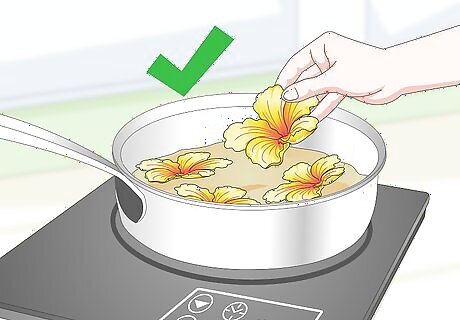
Use the hibiscus flower in your cooking for extra flavor and color. You can add hibiscus to your cooking just like you would other edible flowers, such as roses and violets. For example, you can use the dried flowers to infuse meringues or simple sugar syrups. You can even use it in marinades, especially for lamb!
Dehydrating the Calyx for Tea
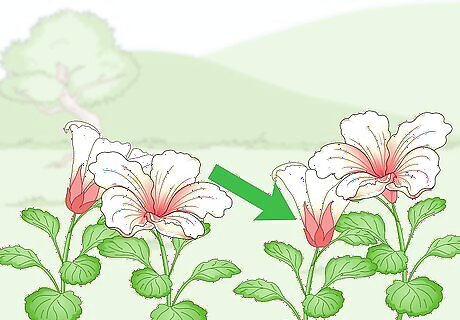
Look for an organic hibiscus sabdariffa and locate the calyx. There are many varieties of the hibiscus flower, but the hibiscus sabdariffa variety is the one that gives you the best flavor. The calyx is the green, trumpet-shaped part at the base of the flower, which will eventually turn red and brittle. The hibiscus must be pesticide-free if you are using it for tea. It does not have to be pesticide-free if you are using it for general crafts. You can try using this method for the actual flowers too, but you will need to adjust the drying time.
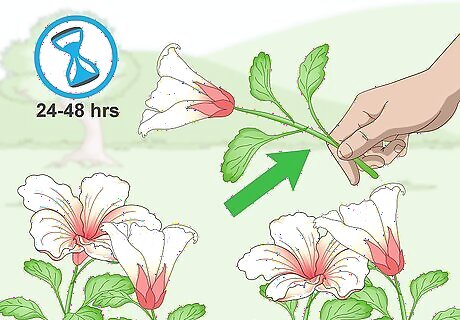
Pick the calyxes 24 to 48 hours after the flower has bloomed. Timing is everything here. Find hibiscus flowers that are in bloom, then wait for them to fall. Locate the red calyx, then pick it after 24 to 48 hours. This will ensure that it is ripe. The calyx should pop off of its stem easily. If you have to pull it off, it is not ripe yet. Try again the next day.
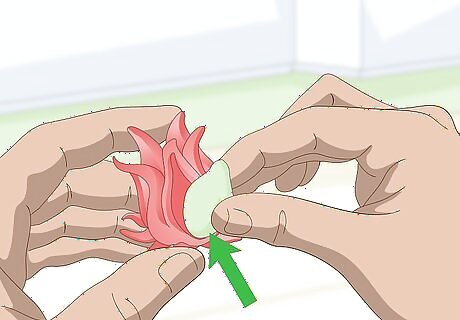
Cut the seed pod away from the calyx. Cut the calyx from the stem of the flower first. Next, cut a shallow slit down the length of the calyx. Pry open the calyx with your fingers, then pop the seed pod out. Try to keep the calyx intact. Don't throw the seed pods away! Allow the seed pods to dry for 1 week, then crack them open and plant the seeds.
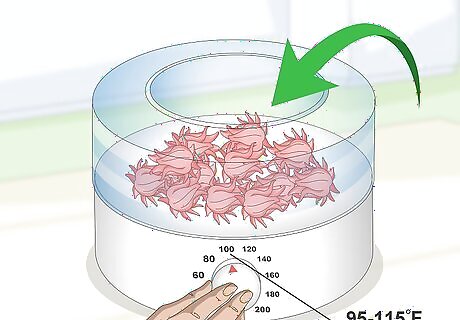
Dry the calyx using a dehydrator. Preheat the dehydrator between 95 to 115 °F (35 to 46 °C). Spread the calyxes on the tray in a single layer. Allow the calyxes to dry completely before taking them out of the dehydrator. This will take about 1 to 4 hours. Each dehydrator is different, so follow the instructions on your model carefully.
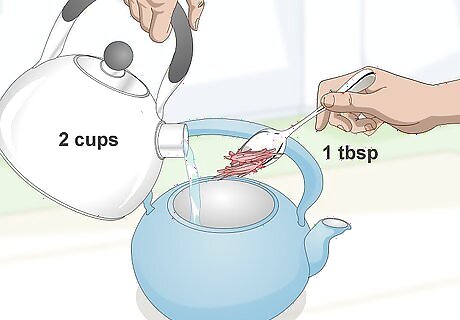
Use the calyx to brew hibiscus tea. Pour 2 cups (475 milliliters) of hot water over 1 tablespoon (15 grams) of dried hibiscus calyxes. Allow the tea to steep for 10 minutes before removing the calyxes. Flavor the tea as desired with lemon juice, sugar, or honey. Serve the tea hot or iced. If you want a stronger tea, use more hibiscus calyxes and increase the brewing time.
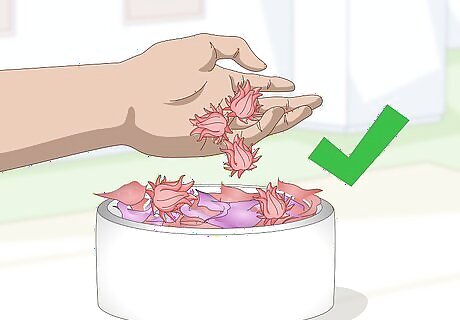
Use the calyx to make potpourri. If hibiscus tea isn't for you, you can add the dehydrated calyx to homemade potpourri. You can try using it in homemade candles or soap as well, but it would be a good idea to crumble it up first so that it isn't as bulky. Alternatively, you can string whole calyxes onto thread and make a pretty garland for your room.




















Comments
0 comment